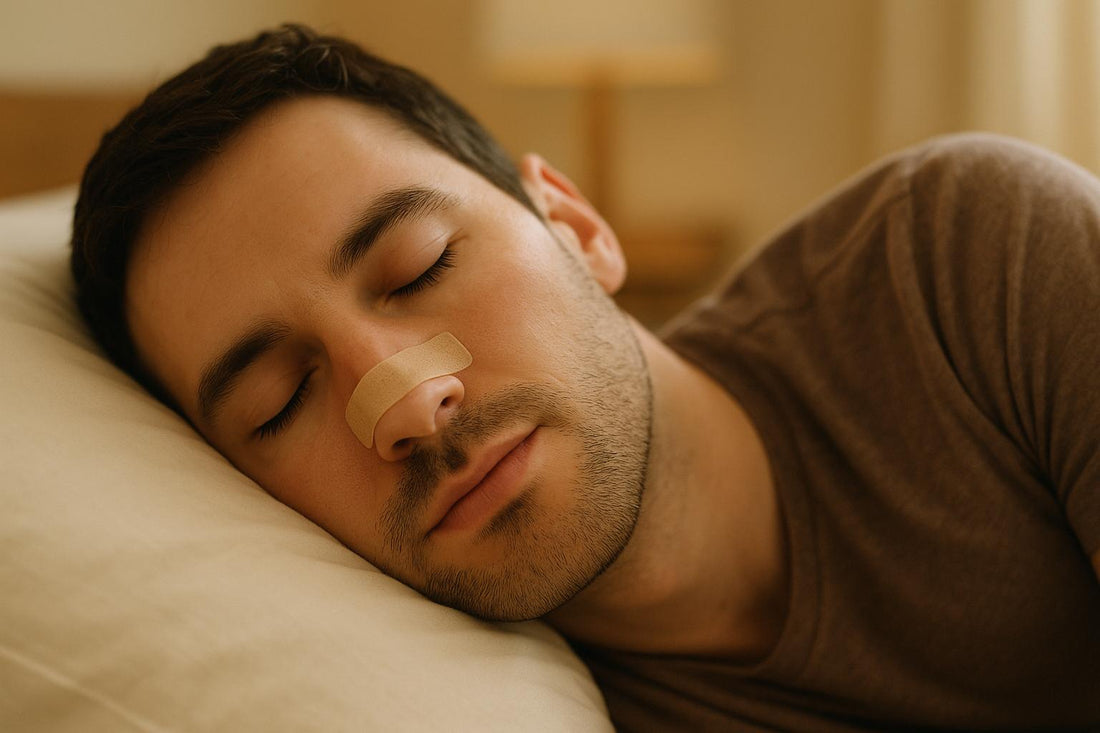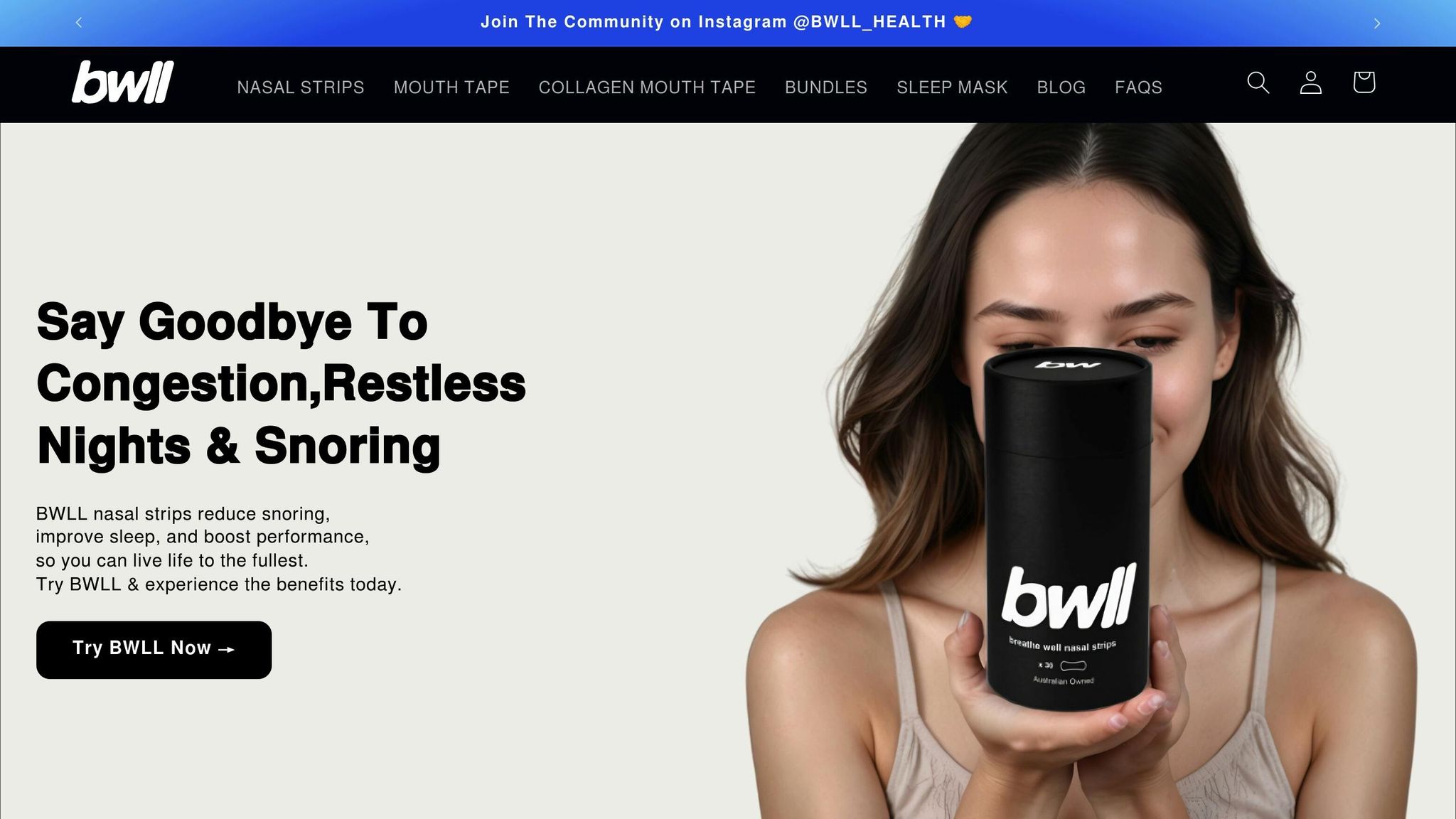
Mouth Taping for Asthma: Research Overview
Share
Mouth taping - placing tape over your mouth while sleeping - has been suggested as a way to improve asthma management by encouraging nasal breathing. While nasal breathing can filter, warm, and humidify air, research so far shows no clinical benefits for asthma control. Studies highlight several drawbacks, including discomfort, poor sleep, and risks for those with nasal blockages or untreated sleep apnoea.
Key findings:
- No improvement in asthma symptoms or lung function has been observed in studies.
- Many participants found the practice uncomfortable, with only a few willing to continue.
- Risks include respiratory distress for individuals with nasal airflow issues.
Safer alternatives, like nasal strips, may help improve airflow without the risks tied to mouth taping. Always consult your doctor before trying new methods for asthma management.
Research Evidence: Benefits and Limitations
Study Results on Mouth Taping
A randomised crossover study involving 50 asthma patients revealed no meaningful changes in morning peak expiratory flow (mean difference of -1 L/min) or symptom scores (mean difference of -0.12).
Out of the 50 participants, 36 tolerated the taping process, but only 11 expressed an interest in continuing the practice. Several participants reported various discomforts, including sore lips, difficulty breathing, an unnatural sensation, poorer sleep quality, feelings of suffocation, or even embarrassment.
In a separate pilot study, researchers noted a trend toward higher end-tidal carbon dioxide (ETCO2) levels with nasal breathing in individuals with mild asthma who habitually breathe through their mouths. However, since this was preliminary research aimed at guiding a larger study, the increase in ETCO2 did not translate into noticeable improvements in asthma symptoms or respiratory function.
These mixed results highlight the need for further investigation and cautious interpretation.
Current Medical Opinion and Evidence
To date, research has not demonstrated any measurable benefits for asthma management through mouth taping. Expert views on the practice remain anecdotal, lacking robust scientific backing. While some individuals may report subjective improvements, these do not substitute for established, evidence-based asthma treatments.
Risks and Who Should Avoid Mouth Taping
Possible Side Effects
Forcing nasal breathing through mouth taping can be uncomfortable, especially for those with restricted nasal airflow. Studies have shown no improvement in asthma control with this method, and there are concerns it could lead to respiratory distress in individuals with nasal blockages. For instance, a 2022 study observed "mouth puffing" in 10 participants, suggesting resistance to enforced nasal breathing. These side effects highlight which groups may face the most risks.
Who Should Not Use Mouth Taping?
Mouth taping is not suitable for everyone, particularly for individuals who already have difficulty breathing through their nose. Here are some specific cases where it should be avoided:
- Nasal obstructions: Conditions like nasal polyps, enlarged tonsils, or chronic congestion can make nasal breathing difficult.
- Untreated sleep apnoea: Mouth taping can mask symptoms of sleep apnoea, delaying proper diagnosis and treatment.
- Severe asthma: Those with asthma or significant difficulty breathing through their nose while awake should avoid this practice without consulting a healthcare professional.
It's essential to speak with a doctor before trying mouth taping, especially if you suspect any underlying issues with nasal breathing.
Benefits vs Risks for Asthma Patients
When weighing the potential benefits and risks, evidence strongly favours sticking to proven asthma treatments over mouth taping.
| Aspect | Potential Benefits | Documented Risks |
|---|---|---|
| Asthma Control | No demonstrated clinical benefits. | May worsen respiratory distress for those with nasal airflow problems. |
| Breathing Quality | Promoting nasal breathing might theoretically improve airway function. | Could lead to respiratory distress in individuals with restricted nasal airflow. |
| Medical Advice | Not recommended by healthcare professionals. | Risks delaying proper diagnosis and treatment of conditions like sleep apnoea. |
These findings underline the importance of prioritising safer, proven methods for improving nasal airflow. Products like BWLL Nasal Strips, which enhance airflow without the risks tied to mouth taping, may be a better option. Always consult your doctor before trying any new intervention, especially if you have asthma or other respiratory concerns.
How Nasal Breathing Works for Asthma
The Science Behind Nasal Breathing
Your nose does more than just filter the air you breathe - it also prepares it. Nasal passages use tiny hairs, called cilia, to trap allergens like dust and pollen. At the same time, they warm and humidify the air, which is especially helpful for those with sensitive, asthmatic airways. Nasal breathing also encourages the production of nitric oxide, a molecule that helps relax and expand airways, potentially improving airflow to the lungs. Plus, the natural resistance created by the nasal passages encourages slower, deeper breathing. This can be particularly useful for countering the rapid, shallow breaths often associated with asthma attacks.
These natural benefits stand out when compared to the limited results seen in studies on mouth taping, highlighting safer and more effective ways to support healthy breathing. These advantages are especially relevant in Australia, where environmental factors can add extra challenges for those with asthma.
Mouth Taping and Nasal Breathing in Australia
Mouth taping has been suggested as a way to force nasal breathing, but Australia's unique environmental conditions can complicate this approach. High pollen levels in spring and summer, bushfire smoke, and dry air during winter (often worsened by indoor heating) can lead to nasal congestion, making enforced nasal breathing difficult and uncomfortable. These local triggers make it more practical to focus on relieving nasal congestion directly.
Instead of relying on mouth taping, using products that help open nasal passages can be a safer and more flexible option. For instance, BWLL Nasal Strips gently lift and open the nasal passages, promoting easier nasal breathing without the risks associated with mouth taping. This is particularly helpful during times when nasal congestion is a common issue for many Australians, offering a practical and comfortable solution.
Research Gaps and Future Studies
What Current Research is Missing
Current studies on mouth taping have some noticeable limitations. Many are small-scale or short-term, making it hard to understand the long-term effects. Additionally, there’s a lack of randomised controlled trials that include a broad range of asthma types, leaving significant questions unanswered. Specific asthma outcomes, like lung function improvements or changes in medication usage, are also underexplored.
Most research has focused on adults with mild asthma, leaving out key groups like children, older adults, and individuals with moderate to severe asthma or exercise-induced asthma. This narrow focus highlights the need for more inclusive studies to provide a clearer picture of mouth taping’s potential benefits and risks.
Areas Needing More Research
To fill these gaps, several areas demand further exploration. Long-term safety concerns, such as potential effects on jaw alignment or dental health, need to be addressed. It’s also crucial to investigate how mouth taping interacts with asthma medications.
Environmental factors unique to Australia - such as high pollen levels, bushfire smoke, and extreme weather - should be studied to understand their influence on the effectiveness of mouth taping. Additionally, research should examine whether this method is equally effective for allergic and non-allergic asthma types. Psychological factors, like its effects on anxiety and sleep quality, also warrant attention. These areas of study could provide valuable insights into the broader role of non-invasive nasal aids for asthma management.
How BWLL Nasal Strips May Help

While the research on mouth taping continues, it’s worth considering safer, drug-free alternatives like BWLL Nasal Strips. These strips promote nasal breathing without completely blocking mouth airflow, offering a more flexible and comfortable option.
Unlike mouth taping, BWLL Nasal Strips gently open the nasal passages, making them a practical solution for individuals struggling with nasal congestion. Designed with hypoallergenic materials, they’re ideal for people with sensitive skin or allergies. Plus, they provide up to 18 hours of relief, ensuring consistent support for nasal breathing, whether during the day or while sleeping.
In future studies, BWLL Nasal Strips could serve as a control tool for comparing different breathing techniques. Their proven safety and ability to improve nasal airflow make them a reliable baseline for researchers examining experimental methods like mouth taping. This could pave the way for a better understanding of effective, non-invasive options for asthma management.
sbb-itb-dc10090
The Science of Mouth Taping
Summary: What We Know About Mouth Taping for Asthma
Current research does not back the use of mouth taping as a way to improve asthma symptoms. Multiple studies have shown no noticeable benefits in morning peak expiratory flow or symptom relief for individuals with asthma.
While some public claims suggest mouth taping can enhance lung function, these assertions conflict with findings from well-reviewed scientific studies. This highlights the importance of relying on proven and safe methods.
A better alternative to consider is BWLL Nasal Strips. These strips are drug-free, hypoallergenic, and designed to gently open nasal passages while allowing normal mouth breathing. They provide up to 18 hours of comfort and support for easier breathing.
FAQs
Is mouth taping safe for asthma patients with nasal blockages or sleep apnoea?
Mouth taping can be risky for individuals with asthma, especially if they experience nasal blockages or suffer from sleep apnoea. When nasal passages are blocked - whether due to allergies, infections, or structural problems - sealing the mouth can make it harder to breathe. In severe cases, this could even lead to suffocation.
For people with sleep apnoea, the practice might worsen symptoms by further restricting airflow. This can result in disrupted sleep and lower oxygen levels, which could have serious health implications. Because of these risks, it’s crucial to speak with a medical professional before trying mouth taping, particularly if you have respiratory issues or sleep-related conditions.
Why is it important to consult a doctor before using mouth taping to manage asthma symptoms?
Why You Should Speak to a Doctor Before Trying Mouth Taping for Asthma
If you have asthma, consulting a doctor before experimenting with mouth taping is absolutely essential. Taping your mouth shut can make breathing harder, especially if you’re dealing with nasal congestion or allergies. In severe cases, this could restrict airflow, reduce oxygen levels, or even lead to suffocation.
Seeking medical advice helps identify any risks and ensures that mouth taping is appropriate for your specific situation. Always rely on professional guidance to avoid potential complications and maintain safe and effective asthma management.
How can nasal breathing help with asthma, and is it more effective than mouth taping?
Nasal breathing offers several advantages for individuals with asthma. By warming, humidifying, and filtering the air, it helps minimise airway irritation and reduce bronchoconstriction. This natural process also improves oxygen exchange, which can alleviate asthma symptoms and enhance overall respiratory function.
In contrast, mouth taping is a technique aimed at promoting nasal breathing during sleep. While it might assist some people in maintaining nasal breathing overnight, research indicates it doesn’t consistently lead to better asthma control. Nasal breathing remains the more effective option, as it naturally conditions the air you breathe, providing greater relief for sensitive airways compared to the effects of mouth taping.